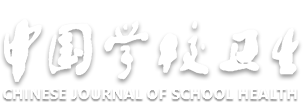Evaluation of the effect of campus tray design on salt intake control among boarding students in Guizhou Province
-
摘要:
目的 探讨使用餐盘代替饭碗对控制学龄学生食盐摄入量的效果,为学生控盐干预提供新的实践证据及思考。 方法 2024年4—5月,采用分层随机整群抽样方法,在贵州省某寄宿制学校四至九年级各抽取1个干预班和1个对照班,共373名学生纳入研究。干预组(n=181)使用餐盘盛取午餐和晚餐,对照组(n=192)使用饭碗,干预时长1个月,期间供餐品种、定价标准及就餐流程与日常保持一致。收集干预前后学生的24 h尿液,并进行问卷调查和体格测量。采用倍差法结合多重线性回归模型分析干预前后钠摄入量变化,评估干预净效应。 结果 干预组终期24 h钠摄入量为(2 222.6±1 013.6)mg,较基线增加94.6 mg,干预前后差异无统计学意义(t=1.10,P>0.05);对照组终期24 h钠摄入量为(2 080.5±895.7)mg,较基线减少190.8 mg,干预前后差异有统计学意义(t=-2.39,P<0.05)。倍差法结果显示,纳入性别、年级和影响钠摄入的饮食行为等因素校正模型后,与对照组相比,干预组24 h钠摄入量净增加232.5 mg[β值(95%CI)=232.5(-40.3~505.2)],净效应无统计学意义(P>0.05)。 结论 仅通过餐具改变尚不足以有效控制学生盐摄入量。应在持续开展基于助推理论的实践探索与循证研究基础上,将减盐教育、支持性环境建设等多维度措施相结合,形成协同增效的干预体系。 Abstract:Objective To explore the effect of replacing rice bowls with trays on controlling the salt intake among school-aged children, providing new evidence and insights for salt-reduction intervention. Methods From April to May 2024, 373 students from grades 4-9 at a boarding school in Guizhou Province were enrolled through stratified random cluster sampling, with one intervention class and one control class per grade. During the intervention period for one month, and the types of meals provided, pricing standards, and dining procedures shall remain consistent with daily operations, the intervention group (n=181) compartmentalized trays for lunch and dinner, while the control group (n=192) still used a rice bowl. Pre- and post-intervention assessments included 24-hour urine collection, questionnaire surveys, and physical measurements. The difference-in-differences analysis combined with multiple linear regression was used to analyze the changes in sodium intake and to evaluate the net effect of the intervention. Results The post-intervention 24-hour sodium intake in the intervention group was (2 222.6±1 013.6) mg, an increase of 94.6 mg from baseline, with no statistically significant difference (t=1.10, P > 0.05). In contrast, the post-intervention 24-hour sodium intake in the control group was (2 080.5±895.7) mg, a decrease of 190.8 mg from baseline, showing a statistically significant difference (t=-2.39, P < 0.05). The difference-in-differences results indicated that after adjusting the model for factors such as gender, grade and dietary behaviors affecting sodium intake, the intervention group showed a net increase of 232.5 mg [β(95%CI)=232.5(-40.3-505.2)] in 24-hour sodium intake compared to the control group, with no statistically significant net effect (P > 0.05). Conclusions Merely changing tableware is insufficient to control children's salt intake effectively. Based on continuous practical explorations and evidence-based research grounded in the nudge theory, multi-dimensional measures such as salt reduction education and the construction of a supportive environment should be integrated to form an intervention system that achieves synergistic and enhanced effects. -
Key words:
- Dinner plate /
- Sodium chloride, dietary /
- Intervention studies /
- Students
1) 利益冲突声明 所有作者声明无利益冲突。 -
表 1 两组学生干预前后用餐行为情况比较
Table 1. Comparison of dining behaviors between two groups of students before and after the intervention
组别 时段 人数 统计值 午餐打菜的数量 晚餐打菜数量 午餐是否吃完菜a 部分 全部 部分 全部 否 是 干预组 基线 181 64(35.4) 117(64.6) 85(47.0) 96(53.0) 131(72.8) 49(27.2) 终期 181 55(30.4) 126(69.6) 71(39.2) 110(60.8) 128(71.1) 52(28.9) χ2值 1.09 2.49 0.10 P值 0.30 0.12 0.75 对照组 基线 192 74(38.5) 118(61.5) 91(47.4) 101(52.6) 141(73.8) 50(26.2) 终期 192 68(35.4) 124(64.6) 87(45.3) 105(54.7) 147(76.6) 45(23.4) χ2值 0.46 0.14 0.31 P值 0.50 0.71 0.58 组别 时段 人数 统计值 晚餐是否吃完菜a 午餐吃菜汤情况a 晚餐吃菜汤情况a 否 是 部分 全部 部分 全部 干预组 基线 181 134(74.0) 47(26.0) 168(93.3) 12(6.7) 162(89.5) 19(10.5) 终期 181 123(68.3) 57(31.7) 154(85.1) 27(14.9) 155(85.6) 26(14.4) χ2值 1.89 8.52 1.33 P值 0.17 <0.01 0.18 对照组 基线 192 133(70.4) 56(29.6) 164(86.3) 26(13.7) 164(85.9) 27(14.1) 终期 192 131(68.6) 60(31.4) 172(89.6) 20(10.4) 163(84.9) 29(15.1) χ2值 0.07 0.74 0.02 P值 0.79 0.39 0.76 注:()内数字为构成比/%,a为有缺失值。 表 2 用餐盘代替饭碗的干预净效应敏感性分析(n=373)
Table 2. Sensitivity analysis of net effect of using plates instead of rice bowls(n=373)
指标 仅纳入完全依从试验方案完成试验的个体 实际使用餐盘情况对分组进行调整后干预分析 β值(95%CI) t值 P值 β值(95%CI) t值 P值 24 h尿钠排出量 251.9(-42.9~546.6) -1.45 0.09 124.6(-76.4~325.5) 1.13 0.22 24 h钠摄入量 279.8(-47.6~607.3) -1.45 0.09 138.4(-84.9~361.7) 1.13 0.22 24 h盐摄入量 0.7(-0.1~1.5) -1.45 0.09 0.4(-0.2~0.9) 1.13 0.22 注:模型校正了性别、年级、饮食行为等因素。 -
[1] 陈力, 张奕, 马涛, 等. 2010—2019年中国7~17岁汉族儿童青少年正常高值血压和血压偏高的流行趋势[J]. 中华预防医学杂志, 2023, 57(4): 499-507.CHEN L, ZHANG Y, MA T, et al. Prevalence trend of high normal blood pressure and elevated blood pressure in Chinese Han children and adolescents aged 7-17 years from 2010 to 2019[J]. Chin J Prev Med, 2023, 57(4): 499-507. (in Chinese) [2] ZHOU J, WU J, JIANG D, et al. National, regional and provincial prevalence of childhood hypertension in China in 2020: a systematic review and modelling study[J]. Lancet Child Adolesc Health, 2024, 8(12): 872-881. [3] 徐培培, 杨媞媞, 许娟, 等. 学生营养改善计划学校供餐配餐状况变迁[J]. 中国学校卫生, 2021, 42(3): 337-341.XU P P, YANG T T, XU J, et al. Changing trends in school-meal catering services as part of the nutrition improvement program for rural compulsory education students[J]. Chin J Sch Health, 2021, 42(3): 337-341. (in Chinese) [4] HE F J, WU Y, FENG X X, et al. School based education programme to reduce salt intake in children and their families (School-Edu Salt): cluster randomised controlled trial[J]. BMJ, 2015, 350: h770. [5] 杨一兵, 王静雷, 张慧琦, 等. 基于家校互动模式的小学生短期减盐综合干预研究[J]. 中国慢性病预防与控制, 2023, 31(8): 616-620.YANG Y B, WANG J L, ZHANG H Q, et al. Study on short-term comprehensive intervention of salt reduction based on home school interactive model in primary school students[J]. Chin J Prev Control Chronic Dis, 2023, 31(8): 616-620. (in Chinese) [6] 翟艳丽, 冯向先, 原建慧, 等. 小学生家庭减盐教育前后食盐摄入和血压变化分析[J]. 中国预防医学杂志, 2020, 21(7): 732-736.ZHAI Y L, FENG X X, YUAN J H, et al. Changes of salt intake and blood pressure in elementary school students and their family members after school based salt reduction education program[J]. Chin J Prev Med, 2020, 21(7): 732-736. (in Chinese) [7] HE F J, ZHANG P, LUO R, et al. An application-based programme to reinforce and maintain lower salt intake (AppSalt) in schoolchildren and their families in China[J]. BMJ Open, 2019, 9(7): e27793. [8] LIU Y, CHU H, PENG K, et al. Factors associated with the use of a salt substitute in rural China[J]. JAMA Netw Open, 2021, 4(12): e2137745. [9] ENSAFF H. A nudge in the right direction: the role of food choice architecture in changing populations' diets[J]. Proc Nutr Soc, 2021, 80(2): 195-206. [10] HOLLANDS G J, SHEMILT I, MARTEAU T M, et al. Altering micro-environments to change population health behaviour: towards an evidence base for choice architecture interventions[J]. BMC Public Health, 2013, 13: 1218. [11] METCALFE J J, ELLISON B, HAMDI N, et al. A systematic review of school meal nudge interventions to improve youth food behaviors[J]. Int J Behav Nutr Phys Act, 2020, 17(1): 77. [12] LYCETT K, MILLER A, KNOX A, et al. 'Nudge' interventions for improving children's dietary behaviors in the home: a systematic review[J]. Obes Med, 2017(7): 21-33. [13] 中国营养学会. 中国居民膳食指南(2022)[M]. 北京: 人民卫生出版社, 2022.Chinese Nutrition Society. Dietary guidelines for Chinese residents (2022)[M]. Beijing: People's Medical Publishing House, 2022. (in Chinese) [14] 张继国, 杜文雯, 黄绯绯, 等. 餐馆菜肴和家庭菜肴钠、脂肪含量及分布研究[J]. 中国健康教育, 2024, 40(1): 36-39.ZHANG J G, DU W W, HUANG F F, et al. Study on concentration and distribution of sodium and fat in dishes cooked in restaurants and families[J]. Chin J Health Educ, 2024, 40(1): 36-39. (in Chinese) [15] 张继国, 杜文雯, 欧阳灿, 等. 2019年北京市和成都市餐馆菜肴钠含量及分布[J]. 卫生研究, 2021, 50(2): 320-322.ZHANG J G, DU W W, OUYANG C, et al. Sodium content and distribution of restaurant dishes in Beijing and Chengdu in 2019[J]. J Hyg Res, 2021, 50(2): 320-322. (in Chinese) [16] THALER R, SUNSTEIN C. Nudge improving decisions about health, wealth, and happiness[M]. New Haven: Yale University Press, 2008: 73-84. [17] 梁敬, 宋超. 助推理论促进健康食物选择的研究进展[J]. 中国食物与营养, 2024, 30(9): 5-9. doi: 10.3969/j.issn.1006-9577.2024.09.002LIANG J, SONG C. The research progress of Nudge theory in promoting healthy food choices[J]. Food Nutr China, 2024, 30(9): 5-9. (in Chinese) doi: 10.3969/j.issn.1006-9577.2024.09.002 [18] MARCANO-OLIVIER M, PEARSON R, RUPARELL A, et al. A low-cost behavioural nudge and choice architecture intervention targeting school lunches increases children's consumption of fruit: a cluster randomised trial[J]. Int J Behav Nutr Phys Act, 2019, 16(1): 20. [19] HANSEN P G, SKOV L R, JESPERSEN A M, et al. Apples versus brownies: a field experiment in rearranging conference snacking buffets to reduce short-term energy intake[J]. J Foodservice Busin Res, 2016, 19(1): 122-130. [20] Food Systems for Health, Nutrition and Food Safety. Nudges to promote healthy eating in schools: policy brief[R]. Geneva: WHO, 2022. [21] KANCHANACHITRA M, CHAMCHAN C, KANCHANACHITRA C, et al. Nudge interventions to reduce fish sauce consumption in Thailand[J]. PLoS One, 2020, 15(9): e238642. -

 点击查看大图
点击查看大图
计量
- 文章访问数: 143
- HTML全文浏览量: 78
- PDF下载量: 23
- 被引次数: 0





 下载:
下载: